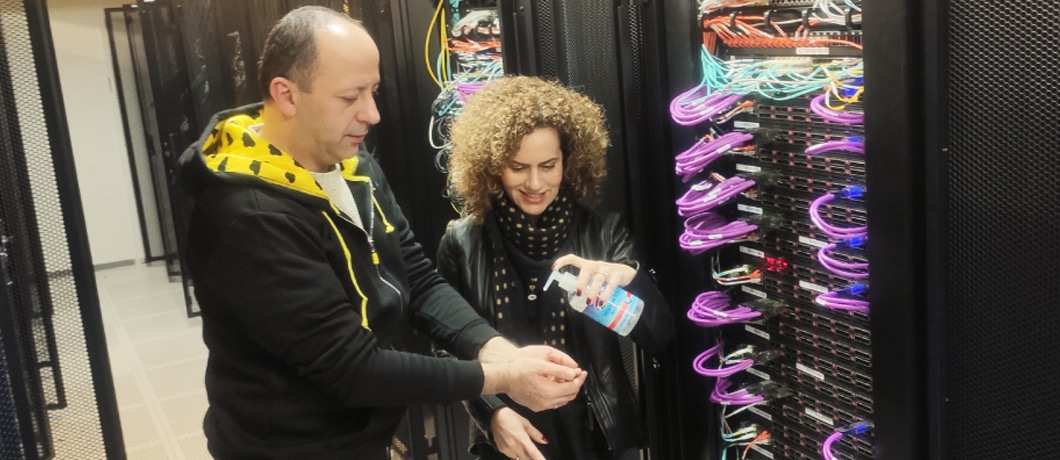My daughter’s university classes have transitioned to online teaching, while she herself came back home to be with family (and have home-made food). My son’s high school published a new timeline based fully on online leaning using Zoom and Webex. We had a pleasant yet somewhat odd day, while my husband and I were working from home, spending most of the day in our respective home offices and attending conference calls, the kids were studying online practically all over the house. We all had a family lunch together – an unusual event on a typical weekday.
Being part of a startup that is disrupting the network architecture of some the largest communications service providers (CSPs) in the world, I was happy to see that the incredible operational teams of networking operators were successful in holding up and supporting the increasing demands on their networks. In fact, many of them have expanded their service offerings to support residential and small businesses at no charge – All four of the major United States carriers — AT&T, Sprint, T-Mobile, and Verizon — have signed on to the FCC’s Keep Americans Connected Pledge. Under this agreement, carriers have agreed to take the following action for at least the next 60 days. While Spain’s Telefónica, this week, added new features to its entertainment offering, including sports coverage and children’s programs, for no extra fees.
Many of us strive to work for meaningful companies that do good. Times like this remind me of the great value and critical role we – the networking professionals – provide to the world. The networks we design, build and operate enable people to have better lives. When it feels like the world is going mad, our networks allow people to maintain their sanity, keep some of their normal routines and cope with the new situation that was forced on them, in a more manageable manner.
Will the network hold up?
Being a networking professional, I was wondering how our service provider’s network would be able to support the changing consumption patterns and ensure quality of service. Luckily it did, but it wasn’t the case for everyone. According to Lightreading, some European operators started to raise the alarm about spikes in Internet traffic as people hunker down to “working from home,” or are watching far too much Netflix. The article also mentioned that Telefónica (Movistar), Orange, Vodafone, Masmovil and Euskaltel said they are reinforcing their networks, but pointed out that IP network traffic has increased almost 40% in recent days, while mobile use has increased by about 50% for voice and 25% for data. Another article stated that some of the world’s largest Internet interconnection hubs- which help route traffic from one provider to another – are reporting record traffic numbers.To learn more download the white paper
Which Network Architecture Is Right for YouIs Coronavirus a black swan event for networking?
Forced to stay at home, many people are adapting to the new situation and are consuming additional networking services for remote learning, remote working, remote health, online entertainment, and online shopping. New applications and content are being created to support these demands. Will Corona change how we live? Will it make us reconsider business travel and adopting video conferencing instead? Will it make remote learning more accessible and create new opportunities to people who couldn’t reach them before? Will it change our healthcare system driving more home care through remote monitoring and video-based medical services? It may, thus making networking into a more critical resource than ever before. It may also introduce new demands on the network infrastructure. This may drive a network renaissance of unbelievable scale and growth, with new innovative services and a smarter infrastructure that will enable fast growth, adaptability and efficiency.Building the Network of the Future – Network Cloud
I have been in the networking industry almost my entire career, and I love it. Networks have changed the way we live, opened new opportunities and were instrumental in flattening the world. After ten wonderful years at Cisco, I thought that it is time for me to move to a different field, so when the call came from DriveNets I wasn’t interested. Once I learned how DriveNets’ Network Cloud was designed, I changed my mind. The concept behind a cloud native network, essentially that it is – distributed, disaggregated and software-based – inspired me. It is so simple and smart in the way it is designed that it makes one wonder how nobody has thought about it before. It truly fundamentally changes networking the way we know it. In the days after Coronavirus, these capabilities can make the difference between whether the good lessons from the current time will last, change our lives, and open new opportunities, or be forgotten. In short, in case you are not familiar with what we do, DriveNets Network Cloud is an open disaggregated high-scale service providers networking solution that adopted the disaggregated architectural model of Hyperscale clouds and adapted it to networking. It is based on cloud-native software running over standard networking white boxes. It is unique in its ability to support any size network from Core to Edge, with one software and a flexible physical infrastructure build with only two white box building blocks. It’s also the only solution in the market that supports AT&T’s distributed disaggregated chassis (DDC) model adopted by OCP in October 2019, and can scale from a single-box router to a cluster of hundreds of white boxes that still operate as a single router. So why is it so relevant? The open architecture, the use of only two white box building blocks for any router size, and the seamless scaling allows CSPs to quickly grow their networks in response to changing needs and do so at a minimal cost. Service providers only need to have a stock of two types of building blocks and within few hours they can double the size of any of their routers in any location. It can practically scale network capacity and network services in a matter of hours. DriveNets’ most experienced IT manager, Mark Kamenetsky, who’s been installing the largest distributed routers in the world building capacity of thousands of Tb/s, said that it only takes him a few hours to grow a single distributed disaggregated router from 20 or 30 Tb/s to a 100 Tb/s. This is impossible to do with today’s largest router chassis that requires a fork-lift upgrade and a long planning lead time. At DriveNets, we certainly didn’t predict the Coronavirus catastrophe, but we did expect that networks will have to change, be more flexible, more adaptable and more economical to operate. We saw the Data Centers go through this transformation, leading to the creation of the hyperscale cloud architecture. We therefore designed our network to be just like cloud – Network Cloud – open, disaggregated, standard, and software-based. The day we step out of the influence of the Coronavirus and go back to normal life, can be a day of new opportunity and growth for all of us. The network included.Download white paper
Which network architecture is right for you?




